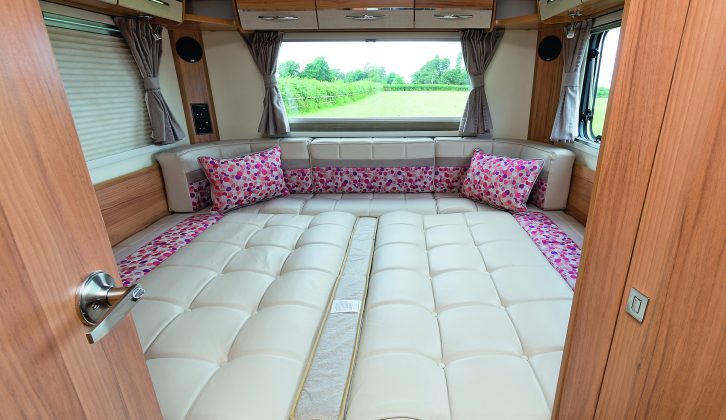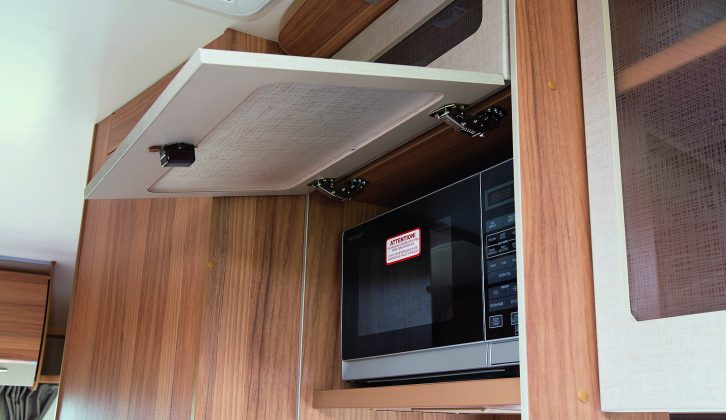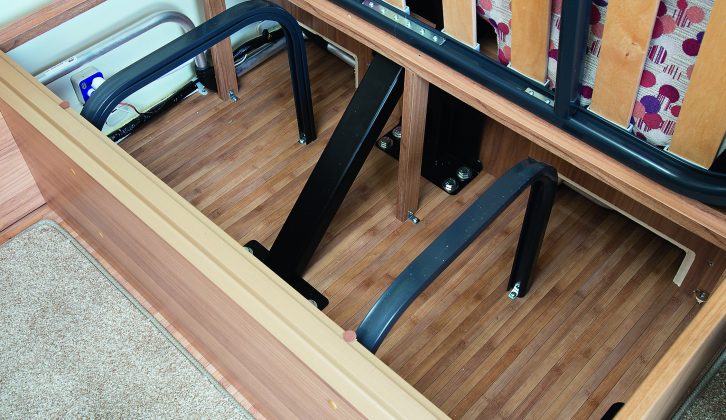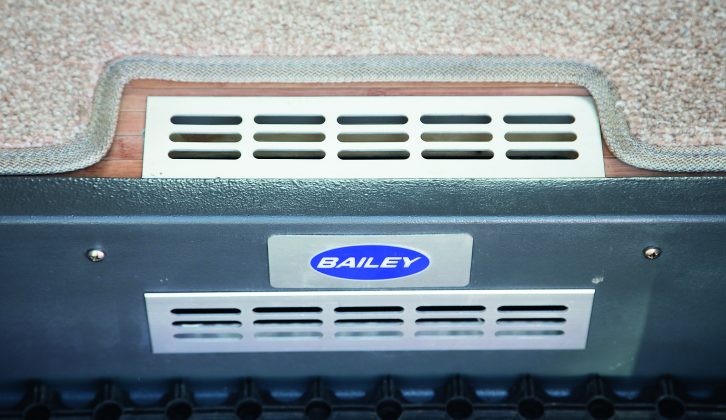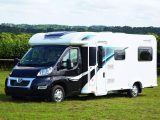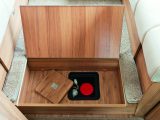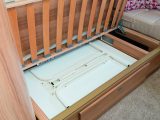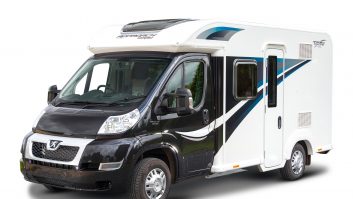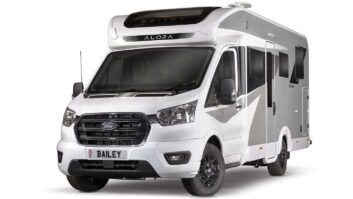Verdict
Bailey has taken a good range and made it even better, and the innovative Approach Autograph 765 is a worthy flagship. The competition simply doesn’t offer as much for the price. Comparable models from Swift’s Bolero range and the Elddis Aspire range costs considerably more than £50,000, while the 765 stays comfortably under that mark. And these competing ’vans aren’t even that comparable, since they won’t sleep six.
Bailey hasn’t just made the UK’s first drop-down-bed motorhome, it has made one of the best drop-down-bed motorhomes in Europe. The 765’s unique, innovative layout makes it one of 2014’s standout new ’vans.
Pros
The heavy-duty chassis
The motorhome’s 630kg payload
The improved habitation body design with rounded rear corners
Cons
Clumsy rear light design
The fact that in order to save space, the sink is in the shower
When Bailey entered the motorhome market in 2011 with its Approach SE coachbuilt, we were confident it would be successful. What we weren’t prepared for was how significant that success would be. Bailey’s ’vans shook up the established order by entering at a unique price point – somewhere between rivals’ mid-range and entry-level offerings – and offering a spec level more associated with pricier models. The company also hit upon the ingenious tactic of using Al-Ko chassis and extra-wide habitation bodies to differentiate its products.
For 2014, Bailey has introduced two all-new motorhome ranges to replace the Approach SE: Approach Autograph and Approach Compact. By replacing the SEs all at once with a two-tier product stable, Bailey is signalling that it’s in the motorhome game for the long run, and expects to do well without the help of novelty value.
The Approach Autographs were launched a couple of months ahead of the Compacts, and they’re the like-for-like replacement for the SEs. Most of the models in the range have the same layouts as outgoing SEs, but with a higher equipment level that includes Alde wet heating, as well as new chassis and habitation designs that allow for double floor sections. There are also a couple of all-new layouts. The most exciting is this, the six-berth rear lounge 765: the UK’s first drop-down-bed low-profile.
Bürstner was the first company to fit drop-down beds in a low-profile back in 2008, and since then the design has spread to most other Continental manufacturers. So far, UK manufacturers have eschewed them, despite the fact that they have almost totally displaced overcab coachbuilts in Continental motorhome ranges. Bailey’s bold move to introduce them here will further differentiate the Bristol-based brand from its competitors. But is its debut drop-down-bed model any good? Read on to find out.
This is the UK’s first drop-down-bed low-profile 'van
Living
The Bailey Approach Autograph 765 has two separate lounging areas – the U-shaped rear lounge and the dinette just rear of the cab seats. This makes it perfect for a family of six, since parents and kids can lounge in separate areas.
Thanks to the extra-wide habitation body, there’s lots of room in both lounges. The rear lounge is especially palatial, which is important, because it’s the only area in which all six occupants can sit at the same time, making it the default dining spot. It suffers from the same setbacks as any other U-shaped lounge – those seated in the middle will have to annoy everyone else if they want to get up mid-meal, for example – but besides these inevitable compromises, it’s pretty much perfect.
The dinette isn’t as comfortable as the rear lounge, for two reasons. Firstly, because of the need to accommodate the kitchen across the corridor, it ends up being a little narrow. Secondly, the drop-down bed is located directly above it, which reduces the amount of headroom. This has the effect of cutting into the feeling of space that you find everywhere else in this motorhome.
Kitchen
We’ve always rated the Bailey’s kitchens, which are spacious and well equipped. Worktop space was a real highlight of the Autograph SEs, and we’re pleased that Bailey has retained this strength with its new Autographs. The worktops are now a classier glossy dark grey, with cream-coloured trim and cream locker doors with frosted glass inserts that let you discern their contents before opening them.
There have also been a few equipment upgrades. The sink is now a large, circular unit with a separate chopping board and drain cover – Bailey’s customers expressed a preference for circular sinks over the rectangular ones fitted to the SE, and the company duly complied. The cooker is also new: a Thetford unit with a built-in oven and grill, three gas burners and an electric hotplate. A microwave oven is still included as standard, and is hidden behind a locker door to improve kitchen unit aesthetics. The only potential weakness of this kitchen is the 103-litre fridge, which may prove too small to hold supplies for six.
Washroom
Midships washrooms are tough to get right, and they often suffer from a lack of space, as well as a confusing array of swinging panels and flimsy curtains designed to cordon off the shower area from the toilet.
Bailey’s designers have managed to avoid this, while ensuring that the washroom doesn’t take up too much space. They’ve done it by making the washroom taper towards the rear of the ’van, so that the central corridor widens slightly as it approaches the rear lounge.
The wider, front-most portion of the washroom is dedicated to the toilet, while the narrower rear section houses a separate shower cubicle. Intriguingly, the sink is located in the shower cubicle, which is a clever space-saving solution – although it does mean that you’ll often have to get your feet wet to use it.
Beds
When we heard Bailey was launching the UK’s first drop-down-bed low-profile, we expected it to be a transverse double bed suspended over the lounge across the width of the vehicle. When lowered, these beds obstruct access between cab and habitation.
To our surprise, the Bristolian firm has positioned the drop-down bed longitudinally, taking up only half of the vehicle’s width, so a corridor is retained through the ’van even when the bed is lowered. Bailey has been able to do this thanks to its uniquely wide habitation bodies. This won’t be an easy act to follow.
This makes the 765 not just a UK first, but a European first: the only transverse drop-down-bed low-profile. The bed is lowered electrically, controlled by a dedicated switch near the control panel. As is usual for electric drop-down beds, there’s a safety cut-off in the form of a cylindrical key, to ensure that the bed never lowers by accident. It’s a spacious and very comfortable bed, equipped with excellent Froli plastic bedsprings. However, it’s only accessible via a ladder, since it lowers about halfway down the height of the interior in order to retain sufficient headroom for the dinette bed underneath it.
The dinette bed, while comfortable and easy to make up, is probably the least appealing set of berths in this ’van. The lumpy cushions – which are contoured to be more comfortable in travelling-seat mode – and the relative lack of headroom due to the bed above both eat into its appeal. However, taken on its own merits, it’s actually a perfectly good bed, and better than most dinette beds we’ve encountered.
The rear lounge bed is the most spacious in this ’van, and the one most likely to be occupied by grown-ups. It’s comfortable and very easy to put together: just slide out the slatted base extension from between the lounge seats and reposition the cushions. It’s only special in one respect – its size. The extra-wide habitation body has allowed Bailey to make this bed into a massive 2.2m x 1.79m.
Storage
Six-berths always pose storage challenges, so it’s great to see that Bailey has put a lot of thought into the 765’s cargo space.
The new chassis design allows for double floor sections across certain portions of the ’van, and while these have been used mainly to house facilities, some of it is devoted to storage. The best example of this is the locker that runs under the rear lounge, which is accessible either from inside the ’van, or from outside via a locker door built into the rear panel.
By housing many of the facilities between the floors, Bailey’s designers have freed space for storage within the habitation. This is most noticeable under the dinette and rear lounge seating, both of which offer loads of space, although the space under the dinette seating is obstructed by the seat-belt frame.
The slatted seat bases all lift up on gas struts, which is an excellent touch, although we found that whenever we absent-mindedly grabbed hold of the bases by their slats and not their frames, we ended up wrenching the struts free from their plastic housings.
Technical Specifications
| Payload | 633 kg |
| MTPLM | 3850 kg |
| Shipping Length | 7.45 m |
| Width | 2.41 m |










